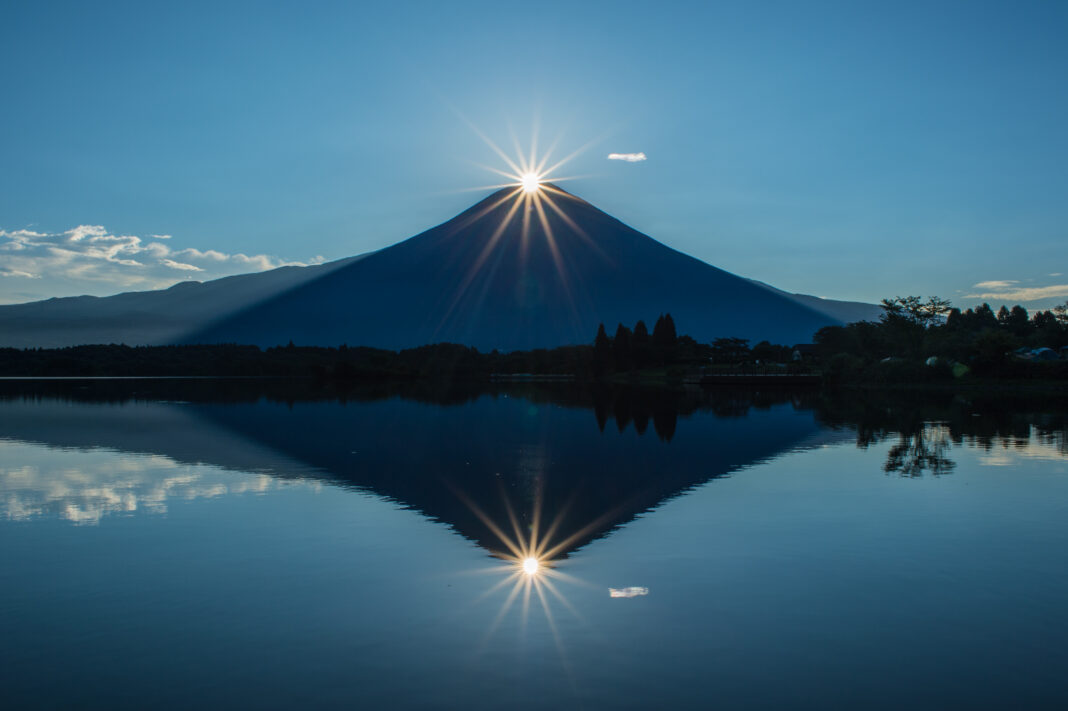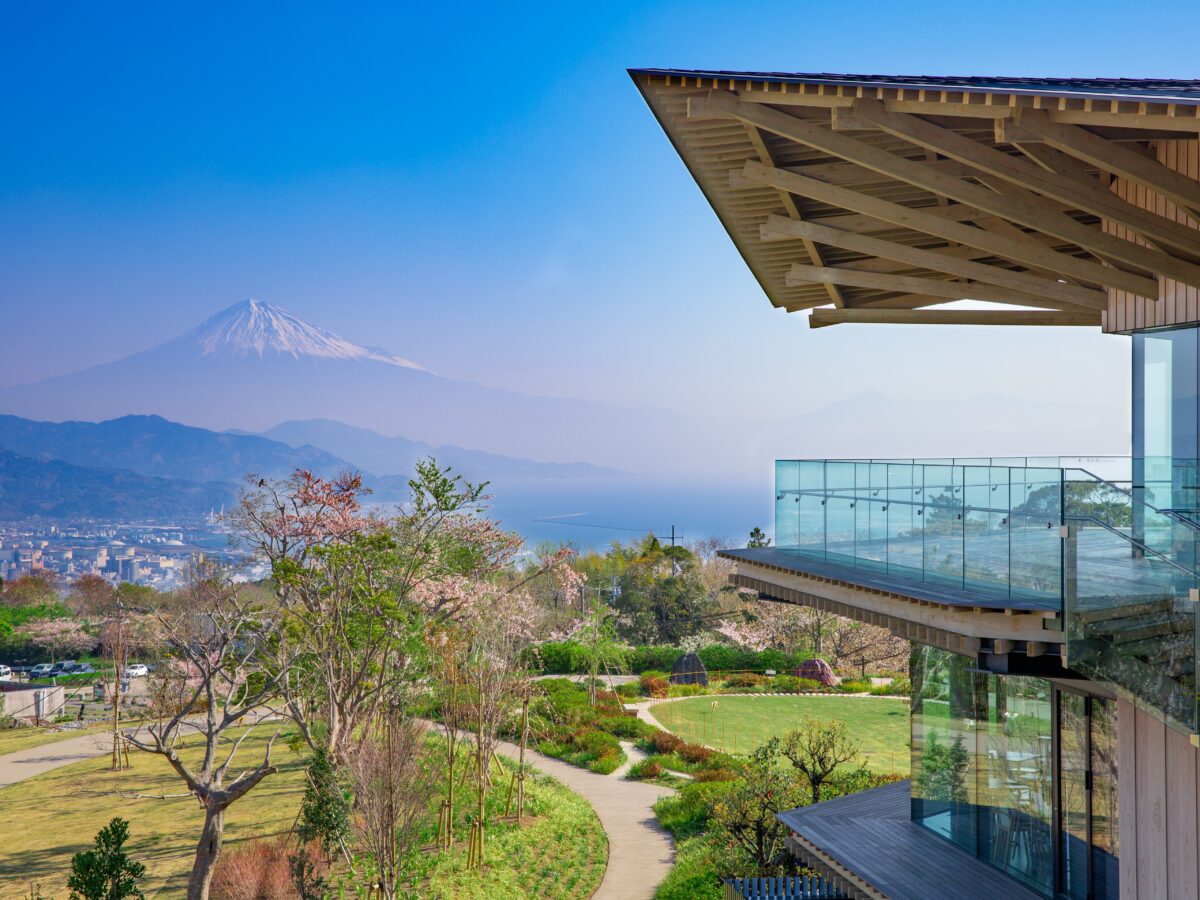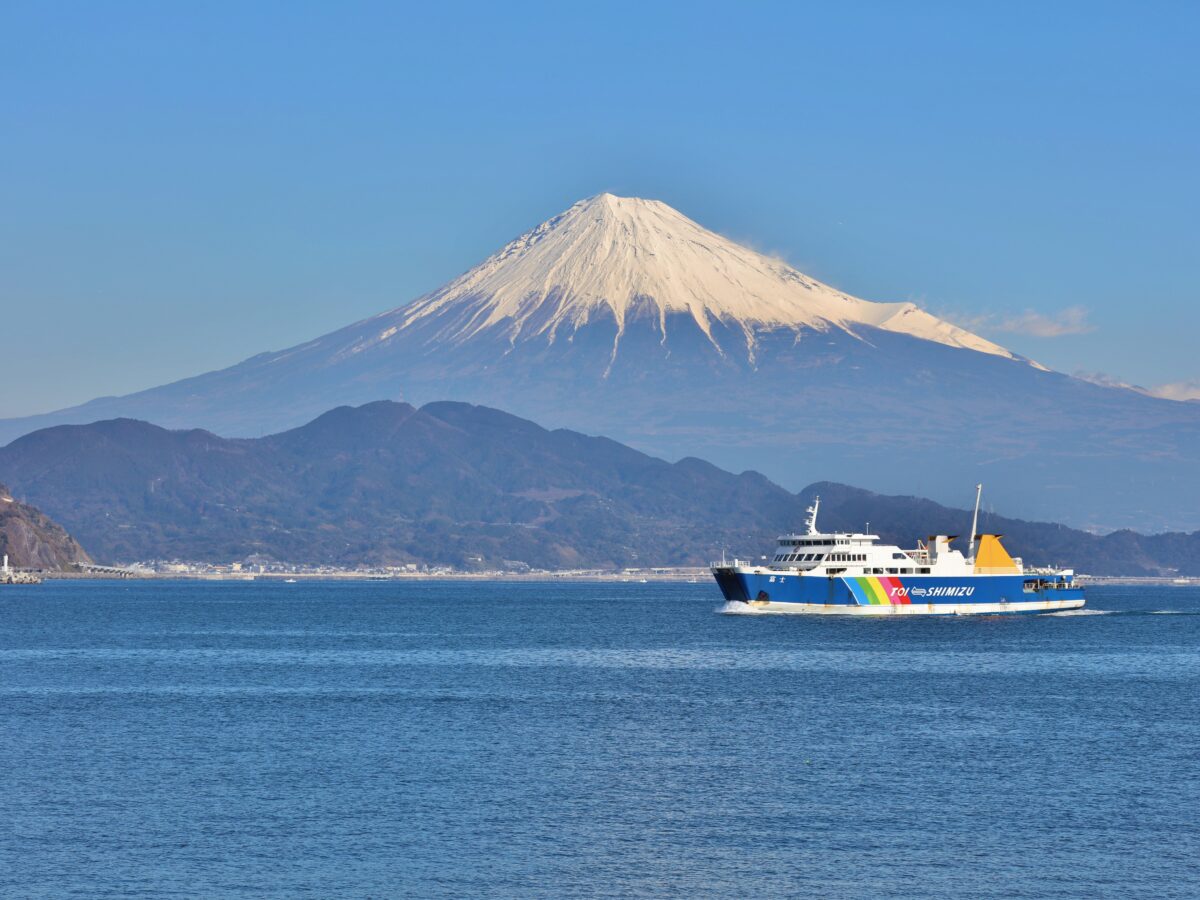Of all the countless places in Shizuoka Prefecture to catch a spectacular view of Mt. Fuji, these are the ones we particularly recommend. May the magnificent views of Mt. Fuji be forever etched in your mind, along with the memories of your trip!
Table of Contents
Miho no Matsubara
Miho no Matsubara, which stretches along the eastern shore of the Miho Peninsula in Shimizu Ward, Shizuoka City, has been known as a scenic spot since the time when the Man’yoshu poetry anthology was compiled in the 8th century. The view one gets when looking up at the sacred Mt. Fuji – with the interwoven scenery of the green pine forests, blue sea and white waves lapping on the shore – is as beautiful as a painting, and in 2013 it was registered as a constituent asset of the World Heritage “Fujisan, sacred place and source of artistic inspiration.”
In Miho no Matsubara, there is a pine tree called the Hagoromo no Matsu, renowned as the setting for the Hagoromo (feathered robe) legend. According to the tale, a female deity hung her feathered robe on the branch of a pine tree in order to take a bath. A fisherman found the robe and tried to take it home, so the deity performed a celestial dance for him in order to get it back. Over the centuries the original pine has been replaced, and the current Hagoromo no Matsu is the third generation.
Nearby you can visit the Shizuoka City Miho no Matsubara Culture & Creativity Center Miho Shirube, where you can learn about the history, culture and charms of Miho.
Nihondaira Yume Terrace
Nihondaira is one of the most scenic spots in Japan and once took first place in a competition for the top 100 sightseeing destinations in the country. From Nihondaira Yume Terrace, newly opened in 2018, visitors can enjoy a beautiful 360-degree panoramic view of Mount Fuji, the Port of Shimizu just below, Suruga Bay, the Izu Peninsula, Shizuoka City, and the southern Alps. Through projection mapping displays, they can also learn about the history, origins, and cultural value of Nihondaira.
From the peak of Nihondaira, visitors can ride a ropeway connecting Nihondaira to the National Treasure Kunozan Toshogu Shrine, enjoying the seasonally changing scenery of Suruga Bay and the Byobu-dani Valley.
Obuchi Sasaba
Located in the northern part of Fuji City, Obuchi Sasaba is blessed with a lush, natural environment where high-quality tea is produced from vast tea plantations covering more than two hectares (five acres). Across the terraced tea plantations one can enjoy a magnificent view of Mt. Fuji.
It is also known as a spectacular spot to take pictures of Mt. Fuji over the tea plantations, without power lines or other any man-made objects obstructing the view. Every year at the time of the new tea season (around the Golden Week holidays in late April and early May), the media and photographers come here to line up their cameras and snap a shot of the beautiful landscape.
Satta Pass
Satta Pass offers a breathtaking view of the towering, sheer cliffs with Suruga Bay spread out in the foreground and Mount Fuji over the sea. It is a spectacular spot for views of Mt. Fuji, also depicted in the woodblock print Yui from the Fifty-three Stations of the Tokaido by Utagawa Hiroshige.
In the past it was known as a perilous pass connecting the Yui-shuku and Okitsuku-juku stations of the Tokaido Highway. It was even referred to as the “Oyashirazu Koshirazu Pass of Tokai” in reference to another famously perilous pass in Niigata Prefecture. Today, the transportation arteries that connect the east and west of Japan – the JR Tokaido Main Line, National Route 1 and the Tomei Expressway – are bundled together along the narrow coastline between Suruga Bay and Mt. Satta jutting out into the sea.
There is now an observatory at the Satta Pass, where visitors can still see for themselves the spectacular scenery that Hiroshige depicted, along with the main transportation arteries of modern-day Japan.
Lake Tanuki
Lake Tanuki is located at the western foot of Mt. Fuji in a corner of the vast Asagiri Highland, and has a circumference of about four kilometers. With a magnificent view of Mt. Fuji directly to the east, the lake shore offers beautiful seasonal scenery such as cherry blossoms and azaleas in the spring and autumn leaves in the fall. You can also enjoy camping, boating, fishing and cycling within this blessed natural environment.
If you are fortunate with respect to the weather, then you might be able to catch a phenomenon known as Double Diamond Fuji in the weeks before and after April 20 and August 20. As the morning sun rises over the peak of Mt. Fuji, it shines in the sky while simultaneously being reflected on the surface of the lake. One could say it is a true example of the art that arises from Earth’s natural bounty interwoven with the universe.
Cape Ose
Cape Ose juts out around 800 meters into Suruga Bay from the southern end of the Nishinoura coast, and has long been known as a place of scenic beauty for its spectacular view of Mount Fuji over Suruga Bay. At the tip of the cape is the Kami-ike Pond, a mysterious and sacred place with an ethereal landscape. Despite its proximity to the sea, it is a freshwater lake, and is counted among the Seven Wonders of Izu.
With its gentle waves and shallow water far out into the sea, the coast offers one of the best beaches in Japan for swimming, and is also known as a mecca for scuba diving, with beautiful coral flowers blooming under the sea.
Kumomi Coast
Kumomi Coast is famous not only for the view you can get of Mt. Fuji across the boulders floating in the sea, but also because it is the southernmost point in the Izu Peninsula where you can get a full view of the sacred mountain. In the summer it flourishes as a picturesque swimming beach where you can get a frontal view of Mt. Fuji, and in recent years, it has prospered year-round as a famous spot for scuba diving and water sports. It is also popular as a camping ground.
Mizugatsuka Park
Located halfway up Mt. Fuji at an altitude of 1,450 meters, Mizugatsuka Park offers an overpowering view of the mountain spreading out before one’s eyes. It is an entirely different appearance from the Mt. Fuji seen from afar. Right in front of you is the Hoei Crater, which was born of the massive eruption in 1707, reminding you that Mt. Fuji is undoubtedly an active volcano.
There is a cross-country course in the park, where visitors can enjoy sports in the cool climate and lush, natural surroundings. Additionally, when personal cars are restricted during the summer, the Mizugatsuka parking lot provides space for climbers using the Fujisan Skyline road (Fujinomiya Tral) Fifth Station to leave their cars. This makes it an entrance to climbing Mt. Fuji.
Mt. Fuji Shizuoka Airport
Mt. Fuji Shizuoka Airport is Shizuoka Prefecture’s gateway to the sky, and as the name would suggest, it is also the closest airport to Mt. Fuji. We recommend you visit the Sekiun-in observation deck built on the east side of the airport terminal building, where you can see airplanes landing and taking off with Mt. Fuji in the background. On weekends, events are held in cooperation with surrounding cities, towns, and flight destinations, making it a place of relaxation not only for air travelers but also for visitors.
Suruga Bay Ferry
The Suruga Bay Ferry crosses Suruga Bay between Shimizu Port in Shizuoka City and Toi Port in Izu City, passing between the World Heritage Site Mt. Fuji and Miho no Matsubara, one of its constituent assets. The magnificent view of Mt. Fuji from the sea and the 360-degree panoramic view of Suruga Bay is a spectacular sight that can only be experienced from aboard this ferry.









43-1200x900.jpg)

